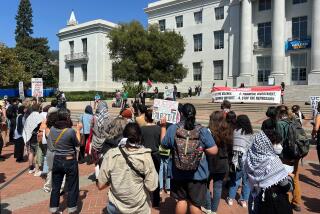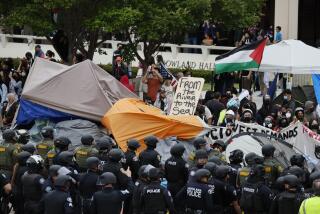CSUN Mulls Growth Amid Crowds, Decay
An aging and deteriorating physical plant and severe campus crowding have sparked a faculty debate at California State University, Northridge over whether the school should continue to expand in the next decade.
âPeople have sort of come to the end of their patience,â said Edda Spielman, faculty Senate president. âThereâs an unwillingness to think about growth until we have at least taken care of the resource problems we have now.â
The debate was triggered by a request from California State University Chancellor W. Ann Reynolds to expand the student enrollment by 19% in the next eight to 10 years--from the equivalent of nearly 21,000 full-time students to 25,000.
On one side are faculty members who say student-body expansion should be halted because growth has already led to campus decay and crowding that is undermining educational efforts. On the other side are the administrators and faculty members who believe CSUN must agree to enroll more students in order to receive additional state money to bring its facilities up to par.
âIâm not opposed to growth,â said political science chairman Eugene C. Price, who occupies the middle ground. âIt may be the only way weâll ever get any resources. But there hasnât been adequate attention paid to our current plant.â
CSUN administrators acknowledge that state funds for upgrading and maintaining the 30-year-old campus and adding facilities have not kept pace with enrollment increases. One reason is that CSUN administrators failed to anticipate the modest gains of the last few years.
Competing for Funds
The administrators say the planned construction of major buildings and the addition of modular classrooms should help alleviate the chronic problems. But in the long run, they contend that expanding enrollment is the only way to compete successfully for a greater share of limited state funds.
âItâs always easier if youâre in a growing environment to get public support,â said Associate Vice President Charles A. Manley, who oversees facilities planning and operations at CSUN. Without increasing enrollment, Manley said it would be politically unrealistic for the university to seek more money from the Legislature for buildings and repairs.
Top California State University administrators agree that resources should be provided to support campus growth, but they emphasize that there can be no promises.
âThe chancellorâs office is no position to guarantee anybody anything,â Lee Kerschner, vice chancellor for academic affairs, said Friday. âYou have a budget process that goes through Sacramento.â
Nevertheless, a CSUN task force recommended âallowing enrollments to grow only if the resources received are commensurate with that growth.â The advisory group determined that student applications could easily boost enrollment to 25,000.
The Academic Affairs Planning Council is expected to make a final recommendation on the growth issue to CSUN President James W. Cleary in February, said Bob H. Suzuki, vice president for academic affairs. Cleary will then make a decision, in which Reynolds is expected to concur, Suzuki said.
For some faculty, however, the answer is as clear as a broken thermostat.
âPlant failures,â English professor Marvin Klotz wrote to Cleary this fall, âhave interfered with instruction and contributed to growing faculty despair.â
In a resolution sent to Cleary this year, the English Department said, âThe physical plant at CSUN is deteriorating at an accelerating pace because it was built as cheaply as possible and has suffered from years of deferred maintenance due to budget cutbacks.â
Major complaints include the following:
A lack of consistently temperate classrooms and routinely functioning elevators in the eight-story Sierra Tower building. Failed heating on cold days leaves students and faculty shivering; malfunctioning air conditioning on hot days has them sweltering, and elevator breakdowns in all seasons leave them stranded, faculty members say.
Escalators are also prone to break down elsewhere on campus.
A dearth of faculty offices that forces instructors to share cramped quarters with one or more colleagues. Some professors say this impairs their ability to meet privately with students, torpedoes morale and leads faculty to spend more time working off campus.
âThe current facilities for faculty are totally inadequate,â Price said of the political science department. âIt is very difficult to consult with students.â
The Faculty Office Building, substantially scaled down from its original design and completed in 1984, provided fewer offices than the facultyâs temporary quarters in a nearby apartment building. The structure also has been beset by heating, air-conditioning and ventilation problems because of design deficiencies from the beginning, Manley said. The architectâs insurance company has agreed to pay for some renovations.
Crowded classrooms and parking lots. Some students are unable to get into required classes because they are full and âthe parking space shortage has moved from a subject of black humor to the threshold of violence-generating stressâ for faculty, staff and students alike, the English Department memo said.
Fire safety concerns. The administration building was charged with 24 fire code violations by the state fire marshal during an October inspection that a university administrator termed âdisastrousâ and âembarrassing.â The Los Angeles City Fire Department cited seven deficiencies during a Nov. 12 inspection of the Sierra Hall complex, where 40% of all classes are held.
The violations included insufficient exit and directional fire signs; inoperable alarm bells, smoke detectors and emergency lighting; and improperly stored combustible liquids. University officials said the most serious deficiency was the failure of a backup generator that provides emergency power to the administration building. A defective relay was replaced after the fire marshalâs inspection.
Some of the more pressing problems, including most of the deficiencies cited by the Fire Departments, already have been corrected, said Martin Holzman, director of physical plant management.
Electrical overload. The universityâs electrical system is at full capacity, which means that plugging in any new device--even a coffee pot--necessitates unplugging something else or rerouting wires, Holzman said. The campus must expand its power capacity in the next few years, he added.
Health hazards. A petition that originated in the geography department this month said the stairwells in the Sierra South building were so âstained, splotched and dirty with âdust curlsâ â that âmany people with respiratory illnesses such as asthma, emphysema and allergies cannot tolerate usingâ them.
The campus structures, many of them 25 years old, handle 30% more students and faculty than they were designed for, campus officials said. To make matters worse, budget cuts forced a 23% cut in custodial staff in the past three years.
But, despite such problems, Dale Hanner, California State University vice chancellor for business, said the physical condition of CSUN âcompares favorablyâ to other state university campuses of similar size. âAll the campuses have had a limited number of dollars,â he said.
Interim steps have been taken to limit enrollment temporarily and to obtain modular buildings for temporary office and classroom space, administrators say. And a systemwide inspection of classrooms is being considered that eventually could result in funding for remodeling and modernizing.
In addition, Manley said construction and renovation slated over the next three years could alleviate some of the overcrowding. He cited plans for a new science building and renovation of the existing one; a new business administration, economics and education complex; an addition to Oviatt Library and conversion of South Library to a computer center.
$77 Million Earmarked
Vice Chancellor Hanner said $77 million has been earmarked for the CSUN construction over the next four years. Bids will be opened for the new science building in January; a construction contract for renovating the existing science building is to be issued in February; bids for the Oviatt Library addition will be opened in March and preliminary planning for the business administration building will begin sometime during the year.
Until some of those facilities are opened, some faculty members believe any increase in students will exacerbate the existing problems.
The CSUN task force on growth said in its Oct. 12 report that the addition of 1,200 students during the past three years was âquite painful to absorbâ because âthe campus received no additional space.â
Manley explained that this occurred because CSUN failed to estimate its future enrollments accurately in past years. Capital and operating budgets are determined by a formula based, in part, on enrollment projections. Manley said the university has since adopted a more efficient system for making these estimates.
Higher No-Show Rate
âIn the past we took more students than we budgeted for,â Manley said. âWe anticipated a higher no-show rate than there was.â
Some student body leaders do not share the faculty outrage over the campus conditions, even though the campus newspaper, the âDaily Sundial,â has chronicled one maintenance problem after another in recent months.
âAs for overall problems of disrepair, I donât see that,â said Associated Students President Laine Hedwall. âWe have a pretty good maintenance program as compared to some other universities Iâve heard of.â
Hedwall, 25, said students are more concerned about being unable to get into classes they want to take, particularly in business, engineering and computer science.
Faculty President Spielman, who claimed she has been forced to flee her office because the extreme heat makes her nauseous, said of the studentsâ lack of concern: âThe faculty has lived with it for a long time. The students come and go.â
And, for some faculty members, even halting increased enrollment is not enough.
The English Department resolution sent to Cleary this fall urged him to go beyond rejecting future growth. They want him to seek a reduction in the current size of the student body.
âAssurances from the Chancellorâs office that they will provide the resources to accommodate such growth ring hollow in view of the Chancellorâs failure to provide for the students, faculty and staff we already have,â the department told Cleary.
âYour principled decision to reduce our student population to match our resources will insure that our educational mission is not subverted by the illusory grandeur of size.â
More to Read
Sign up for Essential California
The most important California stories and recommendations in your inbox every morning.
You may occasionally receive promotional content from the Los Angeles Times.










